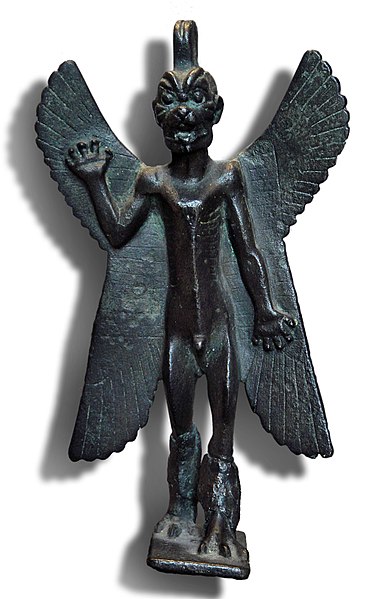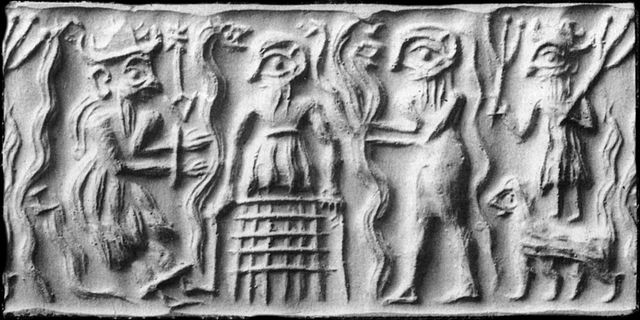Ifrit, also spelled as efreet, afrit, and afreet, plural عفاريت ʿafārīt), is a powerful type of demon in Islamic culture. The ʿafārīt are often associated with the underworld and identified with the spirits of the dead, and have been compared to evil geniī loci in European culture. In Quran, hadith, and Mi'raj narrations the term is always followed by the phrase "among the jinn". In later folklore, they developed into independent entities, identified as powerful demons or spirits of the dead who sometimes inhabit desolate places such as ruins and temples. Their true habitat is the Jahannam or underworld.
In this illustration from the Hamzanama, the flaming eyes of the ifrit Arghan the Div are slightly crossed and his orange skin spotted all over; he carries a chest over the waters on behalf of Hamza.
Makhan embraced by an ifrit. Illustration to Nizami Ganjavi's poem Hamsa. Bukhara, 1648.
The ifrit Al-Malik al-Aswad (The Black King) sitting on the right listening to the complaints of jinn; from a manuscript in the late 14th century Book of Wonders
Mask depicting Bes, ancient Egypt deity, sometimes identified with afarit by Muslim Egyptians, early 4th–1st century BC (Walters Art Museum, Baltimore)
A demon is a malevolent supernatural entity. Historically, belief in demons, or stories about demons, occurs in folklore, mythology, religion, and literature; these beliefs are reflected in media including comics, fiction, film, television, and video games. Belief in demons probably goes back to the Paleolithic age, stemming from humanity's fear of the unknown, the strange and the horrific. In ancient Near Eastern religions and in the Abrahamic religions, including early Judaism and ancient-medieval Christian demonology, a demon is considered a harmful spiritual entity that may cause demonic possession, calling for an exorcism. Large portions of Jewish demonology, a key influence on Christianity and Islam, originated from a later form of Zoroastrianism, and was transferred to Judaism during the Persian era.
Bronze statuette of the Assyro-Babylonian demon king Pazuzu, c. 800–700 BCE, Louvre
Mephistopheles (a medieval demon from German folklore) flying over Wittenberg, in a lithograph by Eugène Delacroix.
Ram-headed demon. The hands probably outstretch to hold two snakes. From a royal tomb in the Valley of the Kings, Thebes, Egypt. End of the 18th Dynasty, around 1325 BCE
Ancient Sumerian cylinder seal impression showing the god Dumuzid being tortured in the Underworld by galla demons








